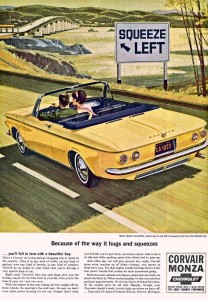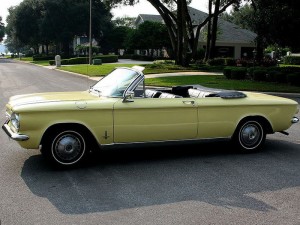 The replacement for the ten year old Austin Healey was a three year old one owner Corvair. I really can’t remember where the money came from for this major upgrade. Possibilities include a “distribution” from my grandparents like the one that enabled my sister and me to buy that 1959 Chevy or some money from my wife’s family. It is for certain, though, that we didn’t buy it with money saved from the wife’s secretarial earnings or my halftime co-op job.
The replacement for the ten year old Austin Healey was a three year old one owner Corvair. I really can’t remember where the money came from for this major upgrade. Possibilities include a “distribution” from my grandparents like the one that enabled my sister and me to buy that 1959 Chevy or some money from my wife’s family. It is for certain, though, that we didn’t buy it with money saved from the wife’s secretarial earnings or my halftime co-op job.
Our 1964 Monza, with 110 HP engine and 4 speed manual transmission, looked pretty much like the car in the ad at right. Although seat belts were showing up quite a bit in the first half of the 1960s, they were not required in new cars until the 1965 model year so that the double entendre of the ad was perfectly legit even if it was’t exactly responsible safety wise. The car remains one of my all time favorites. It looked great, was fun to drive, and even handled snow better than most cars of the day.
It’s tough to write more than a paragraph or two about the Corvair without mentioning Ralph Nader. There is a common misconception that Nader’s 1965 book, Unsafe at Any Speed, killed the Corvair. The marketplace killed the Corvair. Americans just were not ready to embrace the unconventional rear-engine design. On the other hand, Nader’s criticism of the car’s handling had some basis in fact. The earliest Corvairs had no front stabilizer bar. To compensate for most of the weight being in the rear, Chevrolet specified a huge difference between front and rear tire pressure (15 PSI front, 26 PSI rear). In practice, that unusual specification was probably not adhered to very well. It didn’t even apply to my car since, for the 1964 model, a front stabilizer bar and transverse-mounted rear spring were added. The suspension was completely redesigned for 1965.
 That’s not our car in the photo but, with the possible exception of that chrome trim around the gas lid, it could be. I believe we had the Corvair for about two years and during that time the incompatibility of our small and spotty paychecks with the need to eat and pay rent became rather clear. This was the car I drove to my first full time job and it was on the way to that job one morning that I tested the car’s crumple zones.
That’s not our car in the photo but, with the possible exception of that chrome trim around the gas lid, it could be. I believe we had the Corvair for about two years and during that time the incompatibility of our small and spotty paychecks with the need to eat and pay rent became rather clear. This was the car I drove to my first full time job and it was on the way to that job one morning that I tested the car’s crumple zones.
I was the third car on the I-75 entrance ramp when the lead car started to accelerate for the merge. I looked at the traffic on the expressway and decided there was a sufficient gap for all three of us. When I turned my attention back to where it should have been, I discovered that the lead car had decided that there wasn’t even enough room for one of us and stopped. Car #2 hit car #1 just a moment before car #3 (me) hit car #2. I don’t know if either of the other drivers was charged with any thing or who paid for their damage. I wasn’t and didn’t. After looking things over and talking to everyone, the policeman handed me a citation listing my offence as “having an accident”. There was no fine or other penalty and I was responsible only for the damage to my own car. That was enough.
The badly wrinkled car was soon sold. Normally that might be the end of the story but I sold this car to a friend and it wasn’t just any friend, the buyer was Dale, the lifelong buddy who has appeared in other posts including the Whizzer and the 4CV. I contacted Dale and got a bit of a memory refresher. The yellow Corvair made it to Darke County where it was fitted with the front end of a non-running green Corvair (1960 I think) that Dale already owned. The front end was painted to match and Dale drove the car to St Louis where he then lived. A blown head gasket revealed itself on the trip. “…about gassed us out”, Dale remembers. “Bad headache for a couple days.” In St Louis, he got a cylinder from a junkyard only to find that the replacement would not clear a crankshaft counterweight. So Dale, “with hacksaw in hand, made a relief in the cylinder and it worked.” Ah, those were the days.
Dale drove the car for quite awhile including a year or so around northern Indiana’s Fort Wayne. Dale’s green Corvair had a gas heater. There was a little burning odor and people looked at the car warily when they first heard the heater burning off excess gas after the engine was turned off but it sure worked good for keeping you warm. 1963 was the last year for the gas heater, even as an option, so the yellow ’64 had only “direct air” heat. Dale’s last comment on the yellow convertible sums it up pretty well, “Sure was a fun car but a crappy heater.”
Previous Wheels: Chapter 9 — 1965 Honda 65
Next Wheels: Chapter 11 — 1967 Dodge
